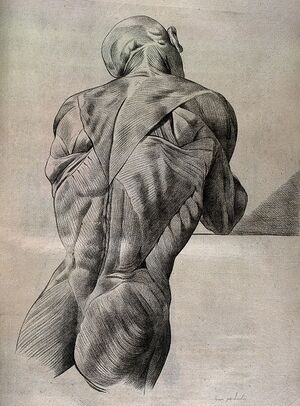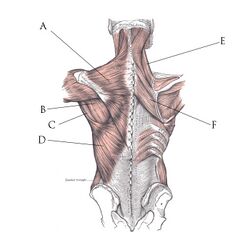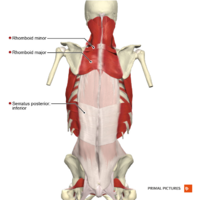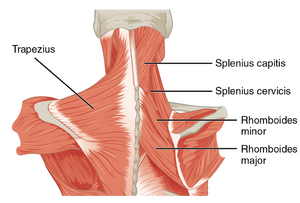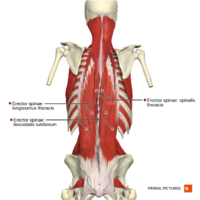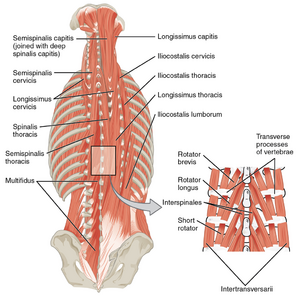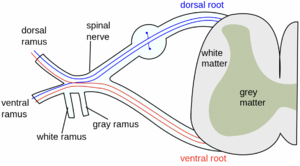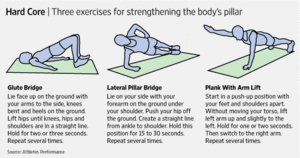Back Muscles: Difference between revisions
No edit summary |
Kim Jackson (talk | contribs) m (Text replacement - "[[Serratus posterior" to "[[Serratus Posterior") |
||
| (15 intermediate revisions by 2 users not shown) | |||
| Line 5: | Line 5: | ||
</div> | </div> | ||
== Introduction == | == Introduction == | ||
[[File: | [[File:Muscles back drawing.jpeg|thumb|Drawing Back Muscles |alt=]] | ||
There are three major groups of back muscles: | There are three major groups of back [[Muscle|muscles]]: | ||
# Superficial: attached to the shoulder girdle | # Superficial: attached to the [[shoulder]] girdle | ||
# Intermediate: attached to the posterior thorax | # Intermediate: attached to the posterior [[Thoracic Anatomy|thorax]] | ||
# Deep: attached to the vertebral column, also known as the intrinsic muscle group<ref>Geeky Medics back Muscles Available: https://geekymedics.com/superficial-back-muscles/<nowiki/>(accessed 24.1.2022)</ref> | # Deep: attached to the vertebral column, also known as the intrinsic muscle group<ref>Geeky Medics back Muscles Available: https://geekymedics.com/superficial-back-muscles/<nowiki/>(accessed 24.1.2022)</ref> | ||
These groups serve to allow: flexion/extension, rotation, and side bending of the back; movement of the limbs; locomotor function; and assistance in the | These groups serve to allow: flexion/extension, rotation, and side bending of the back; movement of the limbs; [[Locomotor Capabilities Index-5|locomotor]] function; and assistance in the breathing<ref name=":0">Modes RJ, Fahrioglu SL. [https://www.ncbi.nlm.nih.gov/books/NBK539746/ Anatomy, Back]. StatPearls [Internet]. 2021 Mar 27. Available:https://www.ncbi.nlm.nih.gov/books/NBK539746/ (accessed 24.1.2022)</ref>. | ||
Additional terminology | Additional terminology | ||
# The superficial and intermediate muscle groups (or extrinsic muscles) are also called immigrant muscles, since they actually represent muscles of the upper limb that have migrated to the back during fetal development. | # The superficial and intermediate muscle groups (or extrinsic muscles) are also called immigrant muscles, since they actually represent muscles of the upper limb that have migrated to the back during fetal development. | ||
# The deep/intrinsic back muscles, are also called true back muscles. They are located deep to the extrinsic muscles, being separated from them by the thoracolumbar fascia<ref name=":1">Ken Hub [https://www.kenhub.com/en/library/anatomy/overview-of-back-muscles Over view of Back Muscles] Available: https://www.kenhub.com/en/library/anatomy/overview-of-back-muscles<nowiki/>(accessed 24.1.2022)</ref>. | # The deep/intrinsic back muscles, are also called true back muscles. They are located deep to the extrinsic muscles, being separated from them by the [[Thoracolumbar Fascia|thoracolumbar fascia]]<ref name=":1">Ken Hub [https://www.kenhub.com/en/library/anatomy/overview-of-back-muscles Over view of Back Muscles] Available: https://www.kenhub.com/en/library/anatomy/overview-of-back-muscles<nowiki/>(accessed 24.1.2022)</ref>. | ||
Physiotherapy Relevance | |||
* A good understanding of the back muscle anatomy is critical for correct diagnosis and treatment. Generalized [[Low Back Pain|back pain]] is a common presenting symptom in clients , with the etiology of the pain commonly traced to a [[Muscle Strain|strain]] of the skeletal muscle. | |||
== Superficial Group == | == Superficial Group == | ||
[[File:Muscles around scapula.jpeg|thumb|250x250px|A Trapezius D Latissimus Dorsi E Levator Scapulae F Rhomboid Major]] | [[File:Muscles around scapula.jpeg|thumb|250x250px|A Trapezius D Latissimus Dorsi E Levator Scapulae F Rhomboid Major]] | ||
The first category is the superficial back muscles. These muscles are located posteriorly on the back, whose function is to move the scapula.. The superficial muscles include<ref name=":0" />: | The first category is the superficial back muscles. These muscles are located posteriorly on the back, whose function is to move the [[scapula]].. The superficial muscles include<ref name=":0" />: | ||
* Trapezius | * [[Trapezius]] | ||
* Latissimus | * [[Latissimus Dorsi Muscle|Latissimus Dorsi]] | ||
* Levator | * [[Levator Scapulae]] | ||
* Rhomboids | * [[Rhomboids]] | ||
Muscles in this group are fairly large and superficial and they are easily identified by palpation<ref>Very well health Superficial Anatomy of the Back and Core Available:https://www.verywellhealth.com/superficial-definition-anatomy-297236 (accessed 24.11.2022)</ref>. | |||
== Intermediate Muscles == | == Intermediate Muscles == | ||
| Line 34: | Line 35: | ||
The intermediate group contains two muscles: | The intermediate group contains two muscles: | ||
* [[Serratus | * [[Serratus Posterior|Serratus posterior superior]] | ||
* [[Serratus | * [[Serratus Posterior|Serratus posterior inferior]] | ||
These muscles run from the vertebral column to the ribcage, and assist with elevating and depressing the ribs. They are thought to have a | These muscles run from the vertebral column to the ribcage, and assist with elevating and depressing the ribs. They are also thought to have a role as accessory [[Muscles of Respiration|muscles for respiration]]<ref>teach me anatomy [https://teachmeanatomy.info/back/muscles/intermediate/ The intermediate back Muscles] Available:https://teachmeanatomy.info/back/muscles/intermediate/ (accessed 24,1,2022)</ref>. | ||
== Deep/Intrinsic Muscles == | == Deep/Intrinsic Muscles == | ||
[[File:Back Muscles gym.jpeg|thumb|A well muscled back|alt=|300x300px]] | |||
The deep muscles of the back are well-developed, and collectively extend from the [[sacrum]] to the base of the [[skull]]. They are associated with the movements of the vertebral column, and the control of [[posture]]. | |||
The muscles themselves are covered by deep [[fascia]], which plays a key role in their organisation. | |||
The deep muscles of the back are subdivided into their own | |||
# Superficial, | |||
# Intermediate and | |||
# Deep layers. | |||
==='''The Superficial Muscles'''=== | |||
[[File:Muscles of the Neck Upper Back.png|thumb|Splenius capitis and cervicis]] | |||
There are two muscles in this group | |||
# [[Splenius Capitis]] | |||
# [[Splenius Cervicis]] | |||
They are both associated with movements of the head and neck. They are located on the posterolateral aspect of the neck, covering the deeper neck muscles<ref>teach me anatomy The deep back Muscles Available:https://teachmeanatomy.info/back/muscles/intrinsic/ (accessed 24,1,2022)</ref>. | |||
==='''Erector Spinae.'''=== | |||
[[File:Muscles of the back erector spinae group Primal.png|thumb|200x200px|Erector spinae group]] | [[File:Muscles of the back erector spinae group Primal.png|thumb|200x200px|Erector spinae group]] | ||
[[File:Muscles of the | The [[Erector Spinae]] (ES) group (medially to laterally) consist of: | ||
# [[Iliocostalis Lumborum|Iliocostalis]] | |||
# [[Longissimus Thoracis|Longissimus]] | |||
# [[Spinalis Thoracis|Spinalis]] | |||
The muscle group is bilateral on either side of the vertebral column and when both sides are engaged function as the primary extensor of the back. Unilaterally they assist with lateral bending and rotation of the spine<ref name=":0" />. | |||
==='''The Deep Intrinsic Muscles - Transversospinales'''=== | |||
[[File:Muscles of the Back.png|thumb|Back: Deep Muscles ]] | |||
[[Transversospinales]] muscle group is a deep group of back muscles that lies deep to the [[Erector Spinae]]. It consists of 3 major subgroups: | |||
# [[Semispinalis Capitis|Semispinalis]], | |||
# [[Lumbar Multifidus|Multifidus]] | |||
# [[Rotatores Muscles|Rotatores]]. | |||
The transversospinalis muscles group runs obliquely and medially from the transverse process of the vertebra below to the spinous process, filling the groove on either side of the spinous process<ref>Drake R, Vogl AW, Mitchell AW. Gray's Anatomy for Students E-Book. Elsevier Health Sciences; 2009 Apr 4.</ref>. | |||
These muscles assist in bending the back posteriorly when contracted bilaterally. When unilateral contraction occurs, they are responsible for assisting with lateral bending and rotation<ref name=":0" />. | |||
== Nerves == | |||
[[File:Spinal rami.png|thumb|Ventral and Dorsal Rami Formation]] | |||
Nervous supply to the intrinsic/deep back primarily arises from dorsal rami of the spinal nerves, providing sensation the skin of the back, and the deep muscles of the back. | |||
This innervation is in contrast to the extrinsic muscles of the back, which are innervated by ventral rami<ref name=":0" />. | |||
== | == Core Muscles and Back Pain == | ||
[[File:Core stability exercises.gif|thumb|Core stability exercises]] | |||
The [[Core Stability|core muscle]]<nowiki/>s consist of the major muscles that stabilizes and controls the pressure inside the trunk; these are the [[Pelvic Floor Anatomy|pelvic floor]], [[Abdominal Muscles|abdominal wall]], back muscles, and [[Diaphragm Anatomy and Differential Diagnosis|diaphragm]] muscles.<ref>Free Medical Dictionary [https://medical-dictionary.thefreedictionary.com/core+muscle Core Muscles] Available:https://medical-dictionary.thefreedictionary.com/core+muscle (accessed 25.1.2022)</ref> | |||
Through core strength training, patients with [[Chronic Low Back Pain|chronic low back pain]] can strengthen their deep trunk muscles. Core strength training, including deep back muscles, is more effective than typical resistance training for alleviating chronic low back pain<ref>Chang WD, Lin HY, Lai PT. [https://www.ncbi.nlm.nih.gov/pmc/articles/PMC4395677/ Core strength training for patients with chronic low back pain]. Journal of physical therapy science. 2015;27(3):619-22. Available: https://www.ncbi.nlm.nih.gov/pmc/articles/PMC4395677/<nowiki/>(accessed 25.1.2022)</ref>. | |||
== References == | == References == | ||
Latest revision as of 13:28, 9 April 2024
Original Editor - Lucinda hampton
Top Contributors - Lucinda hampton and Kim Jackson
Introduction[edit | edit source]
There are three major groups of back muscles:
- Superficial: attached to the shoulder girdle
- Intermediate: attached to the posterior thorax
- Deep: attached to the vertebral column, also known as the intrinsic muscle group[1]
These groups serve to allow: flexion/extension, rotation, and side bending of the back; movement of the limbs; locomotor function; and assistance in the breathing[2].
Additional terminology
- The superficial and intermediate muscle groups (or extrinsic muscles) are also called immigrant muscles, since they actually represent muscles of the upper limb that have migrated to the back during fetal development.
- The deep/intrinsic back muscles, are also called true back muscles. They are located deep to the extrinsic muscles, being separated from them by the thoracolumbar fascia[3].
Physiotherapy Relevance
- A good understanding of the back muscle anatomy is critical for correct diagnosis and treatment. Generalized back pain is a common presenting symptom in clients , with the etiology of the pain commonly traced to a strain of the skeletal muscle.
Superficial Group[edit | edit source]
The first category is the superficial back muscles. These muscles are located posteriorly on the back, whose function is to move the scapula.. The superficial muscles include[2]:
Muscles in this group are fairly large and superficial and they are easily identified by palpation[4].
Intermediate Muscles[edit | edit source]
The intermediate group contains two muscles:
These muscles run from the vertebral column to the ribcage, and assist with elevating and depressing the ribs. They are also thought to have a role as accessory muscles for respiration[5].
Deep/Intrinsic Muscles[edit | edit source]
The deep muscles of the back are well-developed, and collectively extend from the sacrum to the base of the skull. They are associated with the movements of the vertebral column, and the control of posture.
The muscles themselves are covered by deep fascia, which plays a key role in their organisation.
The deep muscles of the back are subdivided into their own
- Superficial,
- Intermediate and
- Deep layers.
The Superficial Muscles[edit | edit source]
There are two muscles in this group
They are both associated with movements of the head and neck. They are located on the posterolateral aspect of the neck, covering the deeper neck muscles[6].
Erector Spinae.[edit | edit source]
The Erector Spinae (ES) group (medially to laterally) consist of:
The muscle group is bilateral on either side of the vertebral column and when both sides are engaged function as the primary extensor of the back. Unilaterally they assist with lateral bending and rotation of the spine[2].
The Deep Intrinsic Muscles - Transversospinales[edit | edit source]
Transversospinales muscle group is a deep group of back muscles that lies deep to the Erector Spinae. It consists of 3 major subgroups:
The transversospinalis muscles group runs obliquely and medially from the transverse process of the vertebra below to the spinous process, filling the groove on either side of the spinous process[7].
These muscles assist in bending the back posteriorly when contracted bilaterally. When unilateral contraction occurs, they are responsible for assisting with lateral bending and rotation[2].
Nerves[edit | edit source]
Nervous supply to the intrinsic/deep back primarily arises from dorsal rami of the spinal nerves, providing sensation the skin of the back, and the deep muscles of the back.
This innervation is in contrast to the extrinsic muscles of the back, which are innervated by ventral rami[2].
Core Muscles and Back Pain[edit | edit source]
The core muscles consist of the major muscles that stabilizes and controls the pressure inside the trunk; these are the pelvic floor, abdominal wall, back muscles, and diaphragm muscles.[8]
Through core strength training, patients with chronic low back pain can strengthen their deep trunk muscles. Core strength training, including deep back muscles, is more effective than typical resistance training for alleviating chronic low back pain[9].
References[edit | edit source]
- ↑ Geeky Medics back Muscles Available: https://geekymedics.com/superficial-back-muscles/(accessed 24.1.2022)
- ↑ 2.0 2.1 2.2 2.3 2.4 Modes RJ, Fahrioglu SL. Anatomy, Back. StatPearls [Internet]. 2021 Mar 27. Available:https://www.ncbi.nlm.nih.gov/books/NBK539746/ (accessed 24.1.2022)
- ↑ Ken Hub Over view of Back Muscles Available: https://www.kenhub.com/en/library/anatomy/overview-of-back-muscles(accessed 24.1.2022)
- ↑ Very well health Superficial Anatomy of the Back and Core Available:https://www.verywellhealth.com/superficial-definition-anatomy-297236 (accessed 24.11.2022)
- ↑ teach me anatomy The intermediate back Muscles Available:https://teachmeanatomy.info/back/muscles/intermediate/ (accessed 24,1,2022)
- ↑ teach me anatomy The deep back Muscles Available:https://teachmeanatomy.info/back/muscles/intrinsic/ (accessed 24,1,2022)
- ↑ Drake R, Vogl AW, Mitchell AW. Gray's Anatomy for Students E-Book. Elsevier Health Sciences; 2009 Apr 4.
- ↑ Free Medical Dictionary Core Muscles Available:https://medical-dictionary.thefreedictionary.com/core+muscle (accessed 25.1.2022)
- ↑ Chang WD, Lin HY, Lai PT. Core strength training for patients with chronic low back pain. Journal of physical therapy science. 2015;27(3):619-22. Available: https://www.ncbi.nlm.nih.gov/pmc/articles/PMC4395677/(accessed 25.1.2022)
